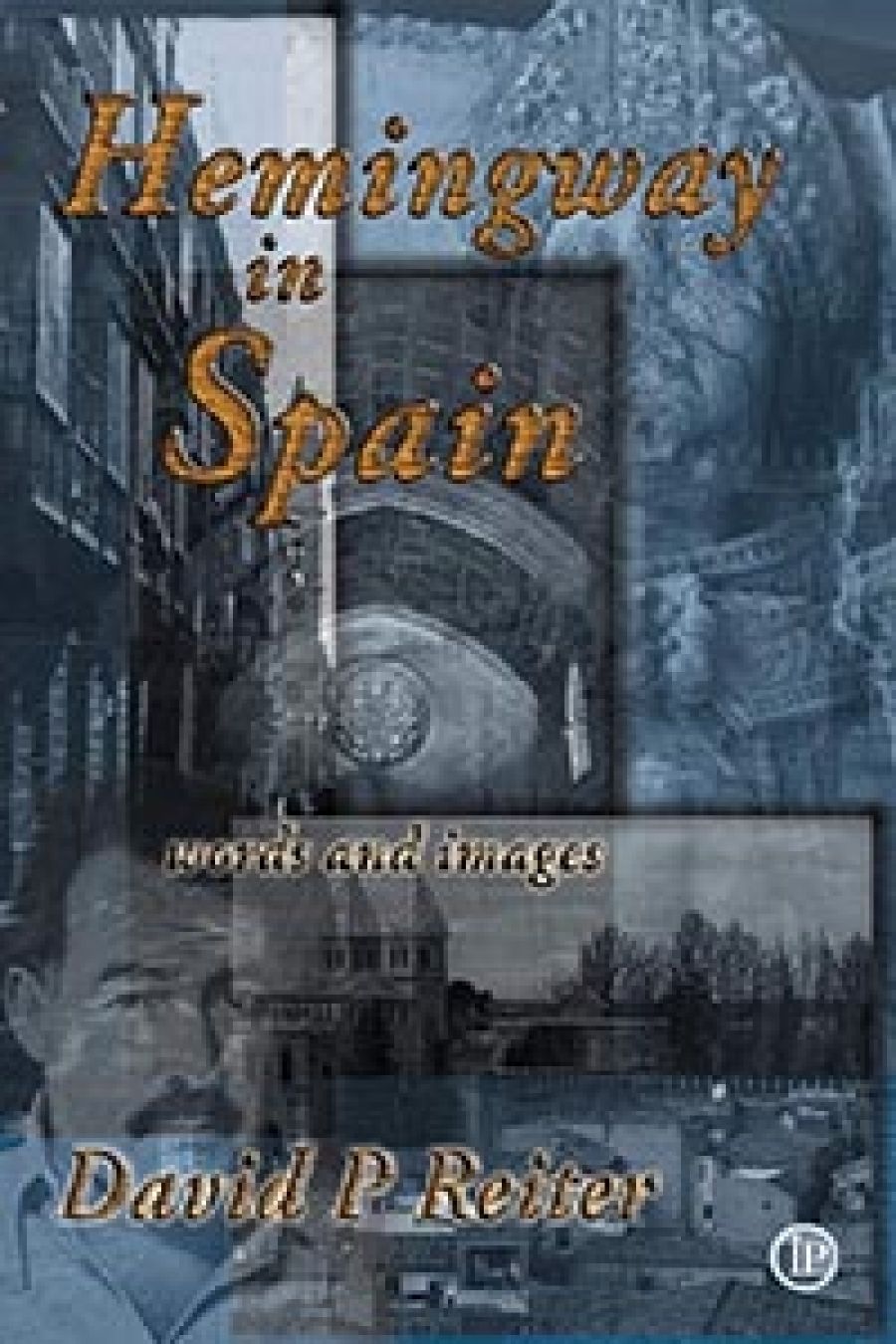
- Free Article: No
- Contents Category: Poetry
- Review Article: Yes
- Article Title: The Hemingway Lens
- Online Only: No
- Custom Highlight Text:
David Reiter’s fourth book, Hemingway in Spain and Selected Poems, opens with the selected work followed by poems that may prove difficult for those who find the sparing endnotes insufficient to enlighten them on Reiter’s subtleties, but often exciting for Hemingway aficionados.
- Book 1 Title: Hemingway in Spain and Selected Poems
- Book 1 Biblio: Interactive Press $17.95 pb, 182 pp
Both sections of Reiter’s book bring a panorama of lost worlds to the reader – from the Kremlin to Flinder’s Breaksea Island, from Norfolk Island markets ‘resurrected mute and weed-free’ to Idaho. They stitch you into a tapestry blending a rather fine weave, with loose threads left hanging just to trip you up if you become complacent. ‘Art does not insist. You must let the fragments/find voice and not worry so much about the gaps.’ (‘Mira a Miró’)
He pulls images from the past suddenly and surprisingly into the present. Discovering his poetry is to imagine yourself looking at an old photo while you are standing at the place where it was taken a few hundred years ago. In Selected Poems you have many opportunities to creep under Reiter’s skin and play the voyeur, as in ‘Mick Angel at the Sistine Chapel’, ‘Man in Barbed Wire, Gallipoli’, ‘Paul Revere Still Rides’, and ‘Sugar Shacks’: ‘Skeins of steam drift over us and I can smell /boiling sap from the log cabins down the path. /"Those are sugar shacks," my father says, "and this/ is how you taste them."‘
Hemingway in Spain, however, is the poetry of a photographer (‘the rigidity a photographer adopts/when going for a shot’). Like Jake in The Sun Also Rises, Reiter stays at a distance from those with whom he converses like a priest behind the lens. Most will give Reiter credit for working so hard to get under Hemingway’s skin if only to find a camouflage for his own.
Poets are notorious burrowers of ruins, an activity which noticeably dominates the work of poets from ‘colonial landscapes’ geographically disconnected from the Euro-Asia landmass. I think of Derek Walcott, Aimee Cesaire, John Tranter, and Dorothy Porter, who puts it so well in Crete: ‘I’ve come to the end / of the world/to wait for this mountain / to flash’. Reiter’s mountain is Ernest Hemingway’s Spain.
Between the reader and Reiter’s words stand the poet, his pseudonyms (several voices of Hemingway speaking to symbols of power and characters from his novels), the poet’s camera, and text taken from Hemingway’s novels. He converses with the likes of Clint Eastwood, Charles V, Picasso, Philip II, Gertrude Stein.
Like Hemingway setting out on an adventure to ‘capture it in a book’, Reiter takes on the personalities of the man who became the hero for the Lost Generation of American writers in Europe in the 1930s. This was the ‘hero’ who copped over two hundred pieces of shrapnel in Italy, bred fighting cocks, loved bullfights, boxing, fishing and hunting, and carried a pistol while a correspondent for Colliers during World War II. In Hemingway in Spain, you meet the older Hemingway, the ghost of the man – the sense of danger transparent, not quite ‘full of blood’. Making use of this more philosophical tone, Reiter is often clever and funny, as when Hemingway chats with Christopher Columbus who
was leaning against his sarcophagus when we came back into the cathedral. ‘I heard you were coming to Sevilla,’ he said. ‘Have you changed your mind about religion?’ He certainly got right to the point ...
The worlds of the volume will strike you from a distance if what you were hoping for was to lock your sensibilities to a found-gem like Hemingway’s find of Miró’s ‘The Farm’ and taking it away for safe keeping to hang it over your bed. The result seems more a layering rather than a fusion of language in poetry, a kind of slipping between sheets in the dark.
Reiter is sparing with his show of emotion and, when it lifts its head, reveals a stronger bonding with men than with women. (Is this Hemingway, Jake or Reiter?) He gives emphasis on the evidence of place, looking for solid structures while leaving you with many solid-seeming facades.
Some readers will have fun testing their memory of Hemingway’s work against Reiter’s use of quotations, mainly from For Whom The Bell Tolls and The Sun Also Rises, presented as italicised text broken into lines of verse. Nevertheless, get beyond the trivia quiz. Reiter manoeuvres, to ironic effect, Hemingway’s comment (in his Nobel Prize acceptance speech) that writing literature would be simple if it only meant writing in some other way what has already been effectively written.


Comments powered by CComment